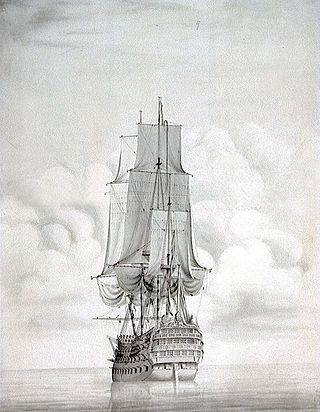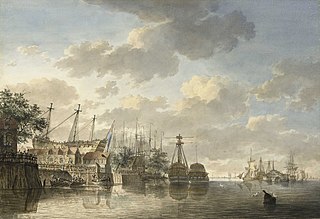
HMS Bellerophon, known to sailors as the "Billy Ruffian", was a ship of the line of the Royal Navy. A third-rate of 74 guns, she was launched in 1786. Bellerophon served during the French Revolutionary and Napoleonic Wars, mostly on blockades or convoy escort duties. She fought in three fleet actions: the Glorious First of June (1794), the Battle of the Nile (1798) and the Battle of Trafalgar (1805). While the ship was on blockade duty in 1815, Napoleon boarded Bellerophon so he could surrender to the ship's captain, ending 22 years of almost continuous war between Britain and France.

HMS Vanguard was a 90-gun second-rate ship of the line of the Royal Navy, built at Portsmouth Dockyard and launched in 1678.

HMS Queen was a three-deck 90-gun second-rate ship of the line of the Royal Navy, launched on 18 September 1769 at Woolwich Dockyard. She was designed by William Bateley, and was the only ship built to her draught. Her armament was increased to 98 guns in the 1780s.

HMS York was a 74-gun third-rate ship of the line of the Royal Navy, built at Rotherhithe by the contract firm Samuel & Daniel Brent, and launched on 7 July 1807. She saw service during the Napoleonic Wars, though is best known for her time spent as a prison ship. She was broken up in March 1854.

HMS Worcester was a 64-gun third-rate ship of the line of the Royal Navy, launched on 17 October 1769 at Portsmouth, and was the fourth ship to bear the name.

HMS Grafton was a 74-gun third-rate ship of the line of the Royal Navy, built by Adam Hayes launched on 26 September 1771 at Deptford Dockyard. One of the largest ships in the navy she had a crew of 550 men.

The Royal Oak-class ships of the line were a class of six 74-gun third rates, designed for the Royal Navy by Sir John Williams. The Alfred class were an enlarged version of the Royal Oak class.

HMS Royal Oak was a 74-gun third rate ship of the line of the Royal Navy, built by Israel Pownoll and launched on 13 November 1769 at Plymouth.
HMS Elizabeth was a 74-gun third-rate ship of the line of the Royal Navy, launched on 23 May 1807 at Blackwall.

HMS Vengeur was a 74-gun third rate Vengeur-class ship of the line of the Royal Navy, launched on 19 June 1810 at Harwich. She had an uneventful career, having participated in no battles or engagements.

HMS Wellesley was a 74-gun third rate, named after the Duke of Wellington, and launched in 1815. She captured Karachi for the British, and participated in the First Opium War, which resulted in Britain gaining control of Hong Kong. Thereafter she served primarily as a training ship before gaining the almost surely unwanted distinction of being the last British ship of the line to be sunk by enemy action and the only one to have been sunk by an air-raid.
HMS Rupert was a 64-gun third rate ship of the line of the Royal Navy, ordered on 26 October 1664 as part of the ship construction programme of that year. She was launched on 26 January 1666 at Harwich Dockyard.

HMS Guernsey was a 50-gun fourth rate ship of the line of the Royal Navy, launched at Blackwall Yard in 1696.

HMS Elizabeth was a 70-gun third rate ship of the line of the Royal Navy, built at Woolwich Dockyard and launched on 1 August 1706.
HMS Yarmouth was a 70-gun third rate ship of the line of the English Royal Navy, built for the navy by a private contractor at Harwich under the 1690 Programme, and launched in 1695.

HMS Lion or Lyon was a 60-gun fourth rate ship of the line of the Royal Navy, built at Chatham Dockyard to the 1706 Establishment and launched on 20 January 1709.

HMS Winchester was a 50-gun fourth-rate ship of the line of the Royal Navy, built at Rotherhithe to the dimensions prescribed by the 1741 proposals of the 1719 Establishment, and launched on 3 May 1744.
HMS Preston was a 50-gun fourth rate ship of the line of the Royal Navy, built at Deptford Dockyard by Adam Hayes to the draught specified in the 1745 Establishment, and launched on 7 February 1757.

HMS Pembroke was a 60-gun fourth rate ship of the line of the Royal Navy, designed by Sir Joseph Allin and built by Thomas Bucknall at Plymouth Dockyard to the draught specified in the 1745 Establishment as amended in 1752, and launched on 2 June 1757.
Rear-Admiral James Bisset (1760–1824) was a Scottish commander in the Royal Navy during the Napoleonic Wars.

















